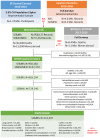Social inequalities, length of hospital stay for chronic conditions and the mediating role of comorbidity and discharge destination: A multilevel analysis of hospital administrative data linked to the population census in Switzerland
- PMID: 36001555
- PMCID: PMC9401154
- DOI: 10.1371/journal.pone.0272265
Social inequalities, length of hospital stay for chronic conditions and the mediating role of comorbidity and discharge destination: A multilevel analysis of hospital administrative data linked to the population census in Switzerland
Abstract
Social factors are recognized determinants of morbidity and mortality and also have an impact on use of medical services. The objective of this study was to assess the associations of educational attainment, social and financial resources, and migration factors with length of hospital stays for chronic conditions. In addition, the study investigated the role of comorbidity and discharge destination in mediating these associations. The study made use of nationwide inpatient data that was linked with Swiss census data. The study sample included n = 141,307 records of n = 92,623 inpatients aged 25 to 84 years, hospitalized between 2010 and 2016 for a chronic condition. Cross-classified multilevel models and mediation analysis were performed. Patients with upper secondary and compulsory education stayed longer in hospital compared to those with tertiary education (β 0.24 days, 95% CI 0.14-0.33; β 0.37, 95% CI 0.27-0.47, respectively) when taking into account demographic factors, main diagnosis and clustering on patient and hospital level. However, these effects were almost fully mediated by burden of comorbidity. The effect of living alone on length of stay (β 0.60 days, 95% CI 0.50-0.70) was partially mediated by both burden of comorbidities (33%) and discharge destination (30.4%). (Semi-) private insurance was associated with prolonged stays, but an inverse effect was observed for colon and breast cancer. Allophone patients had also prolonged hospital stays (β 0.34, 95% CI 0.13-0.55). Hospital stays could be a window of opportunity to discern patients who need additional time and support to better cope with everyday life after discharge, reducing the risks of future hospital stays. However, inpatient care in Switzerland seems to take into account rather obvious individual needs due to lack of immediate support at home, but not necessarily more hidden needs of patients with low health literacy and less resources to assert their interests within the health system.
Conflict of interest statement
The authors have declared that no competing interests exist.
Figures





Similar articles
-
Social disparities in unplanned 30-day readmission rates after hospital discharge in patients with chronic health conditions: A retrospective cohort study using patient level hospital administrative data linked to the population census in Switzerland.PLoS One. 2022 Sep 22;17(9):e0273342. doi: 10.1371/journal.pone.0273342. eCollection 2022. PLoS One. 2022. PMID: 36137092 Free PMC article.
-
Social and Regional Factors Predict the Likelihood of Admission to a Nursing Home After Acute Hospital Stay in Older People With Chronic Health Conditions: A Multilevel Analysis Using Routinely Collected Hospital and Census Data in Switzerland.Front Public Health. 2022 May 9;10:871778. doi: 10.3389/fpubh.2022.871778. eCollection 2022. Front Public Health. 2022. PMID: 35615032 Free PMC article.
-
Determinants of aggregate length of hospital stay in the last year of life in Switzerland.BMC Health Serv Res. 2016 Sep 1;16(1):463. doi: 10.1186/s12913-016-1725-7. BMC Health Serv Res. 2016. PMID: 27586660 Free PMC article.
-
Factors associated with hospital stay length, discharge destination, and 30-day readmission rate after primary hip or knee arthroplasty: Retrospective Cohort Study.Orthop Traumatol Surg Res. 2019 Sep;105(5):949-955. doi: 10.1016/j.otsr.2019.04.012. Epub 2019 Jun 15. Orthop Traumatol Surg Res. 2019. PMID: 31208932 Review.
-
Early discharge hospital at home.Cochrane Database Syst Rev. 2017 Jun 26;6(6):CD000356. doi: 10.1002/14651858.CD000356.pub4. Cochrane Database Syst Rev. 2017. PMID: 28651296 Free PMC article. Review.
Cited by
-
Total Abdominal Colectomy Versus Diverting Loop Ileostomy and Antegrade Colonic Lavage for Fulminant Clostridioides Colitis: Analysis of the National Inpatient Sample 2016-2019.J Gastrointest Surg. 2023 Jul;27(7):1412-1422. doi: 10.1007/s11605-023-05682-0. Epub 2023 Apr 20. J Gastrointest Surg. 2023. PMID: 37081220
-
Hospital length of stay and 30-day readmissions in older people: their association in a 20-year cohort study in Italy.BMC Geriatr. 2023 Mar 21;23(1):154. doi: 10.1186/s12877-023-03884-4. BMC Geriatr. 2023. PMID: 36941535 Free PMC article.
-
Frailty and hospital outcomes among patients with neurological disorders.Neurol Sci. 2025 Aug;46(8):3611-3617. doi: 10.1007/s10072-025-08144-4. Epub 2025 Apr 3. Neurol Sci. 2025. PMID: 40178742 Free PMC article.
-
Social disparities in unplanned 30-day readmission rates after hospital discharge in patients with chronic health conditions: A retrospective cohort study using patient level hospital administrative data linked to the population census in Switzerland.PLoS One. 2022 Sep 22;17(9):e0273342. doi: 10.1371/journal.pone.0273342. eCollection 2022. PLoS One. 2022. PMID: 36137092 Free PMC article.
-
A Quality Improvement Project to Reduce Rapid Response System Inequities for Patients with Limited English Proficiency at a Quaternary Academic Medical Center.J Gen Intern Med. 2024 May;39(7):1103-1111. doi: 10.1007/s11606-024-08678-x. Epub 2024 Feb 21. J Gen Intern Med. 2024. PMID: 38381243 Free PMC article.
References
-
- Bayer-Oglesby L, Bachmann N, Zumbrunn A. Social situation and hospitalisation due to chronic conditions | OBSAN [Internet]. 2020 [cited 2021 Mar 9]. https://www.obsan.admin.ch/en/publications/social-situation-and-hospital...
Publication types
MeSH terms
LinkOut - more resources
Full Text Sources

